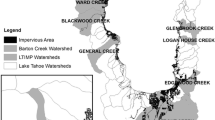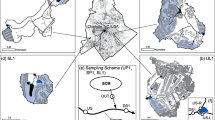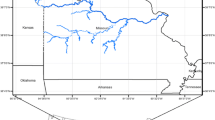Abstract
Rapid urbanization and agricultural development have altered flow and pollutant loading regimes resulting in poorly understood pollutant transport regimes and inadequately conceived management practices. Four years of hydrologic and water quality data (i.e., stream flow, suspended sediment, nitrate, nitrite, total ammonium, total inorganic nitrogen, and total phosphorus) were collected using a five-site nested-scale study design in a representative mixed-land-use watershed. Cumulative nested sub-basin drainage areas ranged from 79 to 208 km2. Daily flow and load duration analyses were used to quantify land use impacts to flow-mediated pollutant loading at multiple flow intervals including high flows (0–10%), moist conditions (10–40%), mid-range flows (40–60%), dry conditions (60–90%), and low flows (90–100%). Pollutant loads ranged across four orders of magnitude for suspended sediments, and three orders of magnitude for nutrient loads during the high flow interval when nearly all of the total pollutant loads were transported (e.g., 99% of suspended sediments, 92% of total inorganic nitrogen, and 95% of total phosphorus loads). Results from stepwise multiple linear regression analyses showed significant relationships between land use, flow, and pollutant load at high flows, moist conditions, and mid-range flow intervals (R 2 > 75.7; p < 0.035). No significant relationships (p < 0.05) were detected during dry conditions, or low flow intervals. Results highlight the need for consideration of combined flow and pollutant loading targets appropriate for watersheds modified by current and ongoing land use and point to a need for long-term and broad-scale efforts to develop achievable hydrologic and water quality recommendations especially in rapidly urbanizing mixed-land-use watersheds.








Similar content being viewed by others
References
Allan JD (2004) Landscapes and riverscapes: the influence of land use on stream ecosystems. Annu Rev Ecol Evol Syst 35:257–284
American Society for Testing and Materials (ASTM) (2007) Standard methods for determining sediment concentrations in water samples. ASTM D:3977–3997
Blanco-Canqui H, Gantzer CJ, Anderson SH, Alberts EE, Ghidey F (2002) Saturated hydraulic conductivity and Its impact on simulated runoff for claypan soils. Soil Sci Soc Am J 66(5):1596–1602
Bernhardt ES, Band LE, Walsh CJ, Berke PE (2008) Understanding, managing, and minimizing urban impacts on surface water flux. Ann NY Acad Sci 1134:61–96
Bernot MJ, Tank JL, Royer TV, David MB (2006) Nutrient uptake in streams draining agricultural catchments of the midwestern United States. Freshw Biol 51(3):499–509
Bilotta GS, Brazier RE (2008) Understanding the influence of suspended solids on water quality and aquatic biota. Water Res 42:2849–2861
Birgand F, Skaggs RW, Chescheir GM, Gilliam JW (2007) Nitrogen removal in streams of agricultural catchments—a literature review. Crit Rev Environ Sci Technol 37:381–487
David MB, Gentry LE (2000) Anthropogenic inputs of nitrogen and phosphorus and riverine export for Illinois, USA. J Environ Qual 29(2):494–508
David MB, Drinkwater LE, McIsaac GF (2010) Sources of nitrate yields in the Mississippi River Basin. J Environ Qual 39(5):1657–1667
Dodds WK, Jones JR, Welch EB (1998) Suggested classification of stream trophic state: distributions of temperate stream types by chlorophyll, total nitrogen, and phosphorus. Water Res 32(5):1455–1462
Dodds WK, Bouska WW, Eitzmann JL, Pilger TJ, Pits KL, Riley AJ, Schloesser JT, Thornbrugh DJ (2009) Eutrophication of U.S. freshwaters: analysis of potential economic damages. Environ Sci Technol 43(1):12–19
Dottori F, Martina MLV, Todini E (2009) A dynamic rating curve approach to indirect discharge measurement. Hydrol Earth Syst Sci 13:847–863
Fletcher TD, Vietz G, Walsh CJ (2014) Protection of stream ecosystems from urban stormwater runoff: the multiple benefits of an ecohydrological approach. Prog Phys Geogr 38:1–13
Harmel RD, Cooper RJ, Slade RM, Haney RL, Arnold JG (2006) Cumulative uncertainty in measured streamflow and water quality data for small watersheds. Trans ASABE 49(3):689–701
Hatt BE, Fletcher TD, Walsh CJ, Taylor SL (2004) The influence of urban density and drainage infrastructure on the concentrations and loads of pollutants in small streams. Environ Manag 34:112–124
Howarth RW, Billen G, Swaney D, Townsend A, Jaworski N, Lajtha K, Downing JA, Elmgren R, Caraco T, Jordan T, Berendse F, Freney J, Kudeyarov V, Murdoch P, Zhu ZL (1996) Regional nitrogen budgets and riverine N & P fluxes for the drainages to the North Atlantic Ocean: natural and human influences. Biochemistry 35(1):75–139
Hubbart JA (2011) Urban floodplain management: understanding consumptive water-use potential in urban forested floodplains. Stormwater 12(6):56–63
Hubbart JA, Zell C (2013) Considering streamflow trend analyses uncertainty in urbanizing watersheds: a baseflow case study in the central United States. Earth Interact 17(5):1–28
Hubbart JA, Holmes J, Bowman G (2010) Integrating science based decision making and TMDL allocations in urbanizing watersheds. Watershed Sci Bull 01:19–24
Hubbart JA, Muzika R-M, Huang D, Robinson A (2011) Improving quantitative understanding of Bottomland Hardwood Forest influence on soil water consumption in an urban floodplain. Watershed Sci Bull 3:34–43
Hubbart JA, Kellner ER, Hooper LT, Lupo AR, Market PS, Guinan PE, Stephan K, Fox NI, Svoma BM (2014) Localized climate and surface energy flux alterations across an urban gradient in the central US. Energies 7:1770–1791
Kellner E, Hubbart JA, Ikem A (2015) A comparison of forest and agricultural shallow groundwater chemical status a century after land use change. Sci Total Environ 529:82–90
Kellner E, Hubbart JA (2016a) A comparison of the spatial distribution of vadose zone water in forested and agricultural floodplains a century after harvest. Sci Total Environ 542(Pt A):153–161
Kellner E, Hubbart JA (2016b) Continuous and event-based time series analysis of observed floodplain groundwater flow under contrasting land-use types. Sci Total Environ 566–567:436–445
Lamba J, Thompson AM, Karthikeyan KG, Fitzpatrick FA (2015) Sources of fine sediment stored in agricultural lowland streams, Midwest, USA. Geomorphology 236:44–53
Leopold LB, Wolman MG, Miller JP (2012) Fluvial processes in geomorphology. Dover Publications, Mineola, NY, p 11501
Lerch RN, Baffaut C, Kitchen NR, Sadler EJ (2015) Long-term agroecosystem research in the Central Mississippi River Basin: dissolved nitrogen and phosphorus transport in a high-runoff-potential watershed. J Environ Qual 44:44–57
Letcher RA, Jakeman AJ, Merritt WS, McKee LJ, Eyre BD, Baginska B (1999) Review of techniques to estimate catchment exports. Environment Protection Authority, Sydney
MDNR (2011) Total maximum daily load for Hinkson Creek Boone County, Missouri. Prepared by the Missouri Department of Natural Resources Water Protection Program
Meybeck M, Laroche L, Dürr HH, Syvitski JPM (2003) Global variability of daily total suspended solids and their fluxes in rivers. Glob Planet Change 39(1):65–93
Miller D, Vandike J (1997) Groundwater resources of Missouri. Missouri Department of Natural Resources Division of Geology and Land Survey Water Resources Rep, 46, p 136
Nelson EJ, Booth DB (2002) Sediment sources in an urbanizing, mixed land-use watershed. J Hydrol 264(1):51–68
Petrucci G, Rodriguez F, Deroubaix JF, Tassin B (2014) Linking the management of urban watersheds with the impacts on the receiving water bodies: the use of flow duration curves. Water Sci Technol 70(1):127–135
Poor CJ, McDonnell JJ (2007) The effects of land use on stream nitrate dynamics. J Hydrol 332(1–2):54–68
Quilbe R, Rousseau AN, Duchemin M, Poulin A, Gangbazo G, Villeneuve JP (2006) Selecting a calculation method to estimate sediment and nutrient loads in streams: application to the Beaurivage River (Quebec, Canada). J Hydrol 326(1–4):295–310
Roy AH, Freeman MC, Freeman BJ, Wenger SJ, Ensign WE, Meyer JL (2005) Investigating hydrological alteration as a mechanism of fish assemblage shifts in urbanizing streams. J N Am Benthol Soc 24:656–678
Royer TV, Tank JL, David MB (2004) Transport and fate of nitrate in headwater agricultural streams in Illinois. J Environ Qual 33(4):1296–1304
Royer TV, David MB, Gentry LE (2006) Timing of riverine export of nitrate and phosphorus from agricultural watersheds in Illinois: implications for reducing nutrient loading to the Mississippi River. Environ Sci Technol 40:4126–4131
Schottler SP, Ulrich J, Belmont P, Moore R, Lauer JW, Engstrom DR, Almendinger JE (2014) Twentieth century agricultural drainage creates more erosive rivers. Hydrol Process 28:1951–1961
Shepard AN, Valentine JF, D’Elia CF, Yoskowitz DW, Dismukes DE (2013) Economic impact of Gulf of Mexico ecosystem goods and services and integration Into restoration decision-making. Gulf Mexico Sci 1(2):10–27
Turnipseed DP, Sauer VB (2010) Discharge measurements at gaging stations. In: U.S. Geological Survey Techniques in Water Resource Investigations Book 3: Applications of Hydraulics. Chap A8. http://pubs.usgs.gov/twri/twri3a8/pdf/TWRI_3-A8.pdf
Vietz GJ, Sammonds MJ, Walsh CJ, Fletcher TD, Rutherfurd ID, Stewardson MJ (2014) Ecologically relevant geomorphic attributes of streams are impaired by even low levels of watershed effective imperviousness. Geomorphology 206:67–78
Vogel RM, Fennessey NM (1994) Flow-duration curves. I: new interpretation and confidence intervals. J Water Resour Plan Manag 120(4):485–504
Walsh CJ, Roy AH, Feminella JW, Cottingham PD, Groffman PM, Morgan RP II (2005a) The urban stream syndrome: current knowledge and the search for a cure. J N Am Benthol Soc 24(3):706–723
Walsh CJ, Fletcher TD, Ladson AR (2005b) Stream restoration in urban catchments through redesigning stormwater systems: looking to the catchment to save the stream. J N Am Benthol Soc 24(3):690–705
Zeiger SJ, Hubbart JA (2015) Nested-scale nutrient yields from a mixed-land-use urbanizing watershed. Hydrol Process 30(10):1475–1490
Zeiger SJ, Hubbart JA (2016) Quantifying suspended sediment flux in a mixed-land-use urbanizing watershed using a nested-scale study design. Sci Total Environ 542:315–323
Acknowledgements
Funding was provided by the Missouri Department of Conservation and the U.S. Environmental Protection Agency Region 7 through the Missouri Department of Natural Resources (P.N: G08-NPS-17) under Section 319 of the Clean Water Act. Additional funding was provided by partners of the Hinkson Creek Watershed Collaborative Adaptive Management program. Results presented may not reflect the views of the sponsors, and no official endorsement should be inferred.
Author information
Authors and Affiliations
Corresponding author
Ethics declarations
Conflict of interest
The authors declare no conflict of interest.
Rights and permissions
About this article
Cite this article
Zeiger, S.J., Hubbart, J.A. Quantifying flow interval–pollutant loading relationships in a rapidly urbanizing mixed-land-use watershed of the Central USA. Environ Earth Sci 76, 484 (2017). https://doi.org/10.1007/s12665-017-6819-y
Received:
Accepted:
Published:
DOI: https://doi.org/10.1007/s12665-017-6819-y




